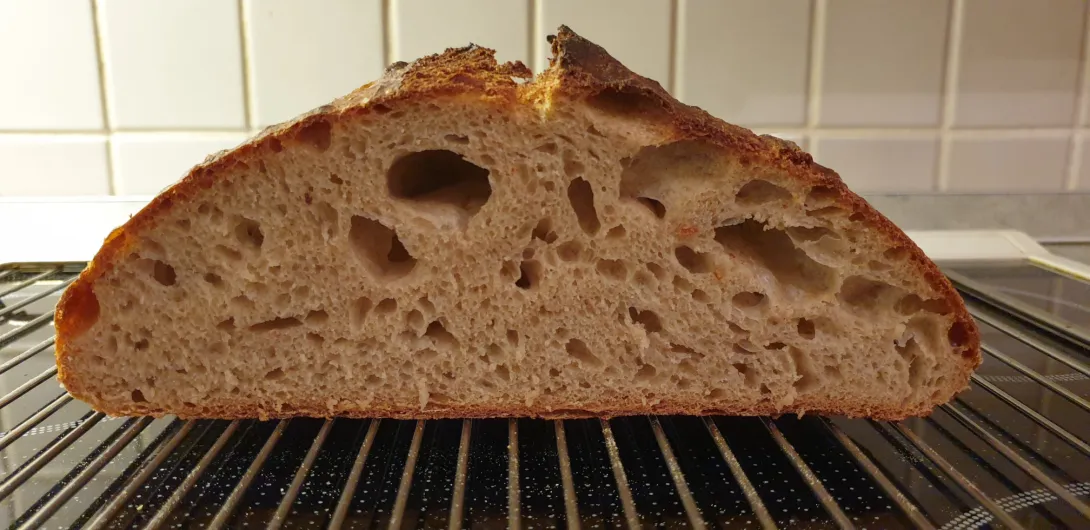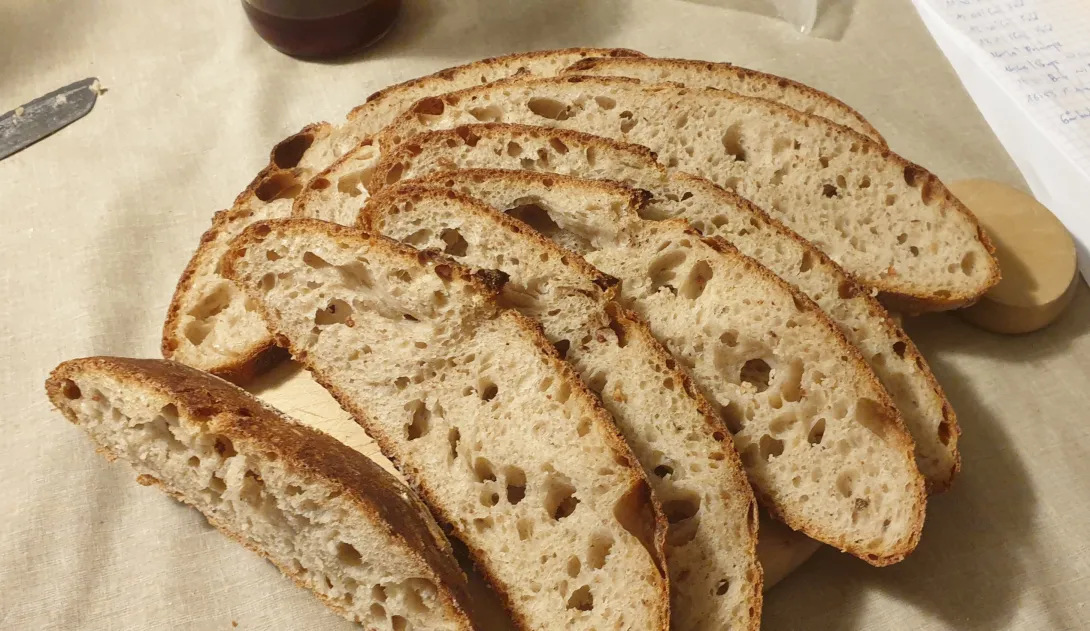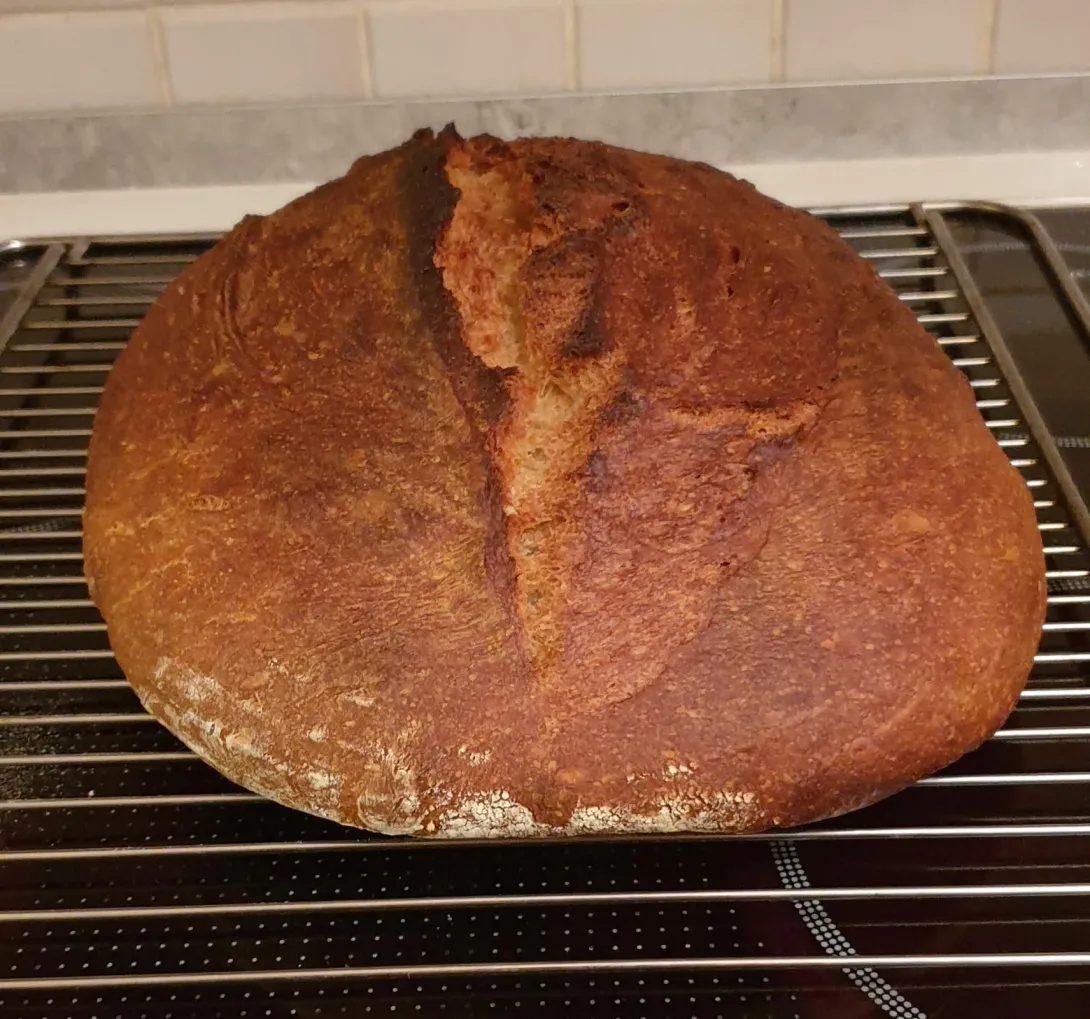
Every time I move the dough from my banneton to the baking sheet it flattens out into a ~ 2cm high puddle, but still has has a very good oven spring (triples in height), which luckily saves the bread! But this makes it really hard to score and the bread slices are also rather wide. Even though he crumb is relatively fluffy and open, the crumb seems not right to me.
Here some further crumb / bread shots:


And here my procedure:
Ingredients:
- (80%) 600g Wheat flour (T550)
- (20%) 150 Whole wheat flour
- (78%) 585g Water
- (0.5%) about 3.75g Instant Yeast
- 1h Autolyse with 75% Hydration
- 3:50h Bulk Ferment (1 Fold at 0:30; 4 Coil folds at 1:00, 1:30, 2:00, 3:15)
- Preshape; 20min Rest; Final shape into batard
- 1:20h final proof in banneton
- preheat oven to 250°C, bake at 230°C 20min with steam and 30min without
Some posts I have found suggested that this could be due to overproofing or bad gluten structure. But this doesn't really make sense because of the good oven spring, does it? Could underproofing or shaping issues be the cause of this? Does anyone of you have an idea what the issue might be?
1 thing missing, and it happens to be one of the most important - temps at the different stages. No temps, so unfortunately no help. Enjoy!
Everything happened at room temeperature (22°C)
Wheat a difference a little piece of info makes. At room temp ie @75 3+hrs of the bulk as you call it may be too long.
I would highly recommend kneading up front, cancel s/f, rise till almost doubled, light knead, almost doubled again, go from there. Dropping water a tad would hurt either. Enjoy!
The crumb and the fact that it has good oven spring despite the fact that it puddles suggests that it is in fact underfermented. However, why does it puddle? It may be a combination of too high hydration and insufficient gluten development and structure building along with perhaps shaping issues.
Benny
+1 Benny, as usual I agree with your assessment! Crumb also indicates some underfermentation IMO. Seeing as the flour is called T550, it's likely French, and 75+% hydration is very ambitious, especially without vigorous gluten development. So likely a combination of all the factors.
Still it looks like a pretty good bread in the end.
Does longer fermentation strengthen the dough / prevent it from spreading?
Only to some degree and only if you develop the gluten during early bulk and build structure with folds again early in bulk. As the CO2 produced by the yeast fill the dough, it increases the structure. However, there will reach a point where the gluten may no longer be strong enough to hold the pressure of the gas and then structure will start to be lost.
I think the gluten structure of my bread is relatively good(would it be able to rise so high in the oven otherwise?). I am making another bread currently, looking good so far. I will try to let it prove a little bit longer and see if that helps.
How much are you working the dough during the initial mixing? To the point that you start to feel some gluten formation? And more importantly, during the progression of coil folds, do you feel the dough getting stronger? Eventually the dough (especially at that hydration) should begin to feel billowy.
The dough will talk to you in various ways, and the feel of it is one of those ways.
Happy baking.
Ted
I knead with slap&folds until the dough passes the window pane test. The dough becomes a bit smoother through the folds, but is still relatively dense on shaping( not really pillow like). I should also mention that the dough already flattens in the banneton (so no domed top). So if the dough is underproofed, could a longer bulk ferment help it keeping its shape?
Here are some pictures of the bread I am currently making:
Before shaping:
Preshaped:
That appears to have good structure and you can see the gases under the skin.
Sadly, it still fell flat before bake and the rose again in the oven. Could it also be a shaping issue?
C my note above about water. Enjoy!
Yeah, reducing the hydration level could help. I might try that next time.
Creepsy, for your room temperature and length of fermentation and proof before baking, you have not enough yeast in your recipe to stretch and strengthen gluten during fermentation. So the bread is flat and the crumb looks the way it looks.
This is a 4hrs straight dough, it needs more yeast to make it ready for shaping and baking in 4hrs at 22C. A t least two if not three times more.
Could a longer bulk ferment also work (6 or 7h)? I have tried that in the past, but it seems like oven spring and oven spring is suffering a lot through that (maybe i bulk fermented too long back then ;D).
Probably. 2 or 3 times longer bulk then. What you are baking is traditional French bread called Pain de Campagne. It usually has 2% compressed yeast if 6 hrs fermentation at 25C is used about 3% fresh yeast if 4 hours straight dough method is used and it is fermented at 24-27C. Your dough is colder and has much less yeast, so it is not ripe by the time you shape it and proof it.
Please, judge by the visual clues: your dough must rise to the maximum volume twice with the punch down (deflating it) in the middle of the fermentation (between these two rises), and only then it is ready to be shaped and proofed and baked. By observing your dough in your real conditions your will discover how much time it needs to mature, to ripen with that amount of yeast, i.e. how much time it would take for it to rise to the maximum volume twice in a row.
Just make sure it rises to the maximum volume which means it should at least quadruple in volume... With T550 my bread dough at your level of hydration would rise while increasing in volume at least sixfold. And then it stops rising and only then you gently deflate it by patting it with the palm of your hand on the table and fold it until it feels tight with a taught smooth surface as in your picture. Then let it rise to the maximum volume again. Deflate and pat it gently again. Gently, if you want to preserve the air pockets, for the rustic open style crumb.
Preshape by folding it. Shape by folding it. Proof until it doubles or triples in volume and feels light, score the surface and bake.
To make dough stronger, more tolerant and not deflating in the proofing basket, fortify it with a pinch of vitamin C (ascorbic acid) in powdered form.
Just from the pictures, the crumb suggests underproofed. At 20% wholegrain the crumb should easily be much airier. Extending bulk fermentation won’t help with that. You have to let final proofing go on for longer.
I suspect there are in fact two separate problems. One is the degree of fermentation, which will mostly determine the state of your crumb. Two is the consistency/strength of the dough before baking i.e. the excessive slackness you describe that leads to a relatively flat loaf.
A couple of clarifying questions:
To be honest, your recipe reads slightly strange to me. A straight dough with a relatively low amount of yeast means a longer slow fermentation. Which is a fine approach, but then why add the long autolyse, and the complication of the coil folds after already kneading to a good windowpane?
I have added 2%(8g) salt, just forgot to add it to the ingredients list.
My flour has 10%-11% protein, ash content is 550mg I think (Thats what T550 stands for as far as I know). Sadly, I was not able to find any high protein flours in germany yet :/. The highest I have used was 12% protein flour for this recipe.
The 78% hydration is likely too high for 10-11% protein flour. I mentioned hydration in my first response as likely too high and I think this confirms it.
So under fermented and over hydrated. Either increase the yeast, ferment warmer and use less water, try a hydration 65-70% to start.
Ah good. Salt is important. It has a tightening effect on the dough and slows down gluten degradation.
However, underproofing is unrelated to the pancaking of the dough. If anything, an underproofed dough should hold its shape well.
I haven't worked with German flours before, but 10-11% protein European flours typically do not benefit from the method you describe (high hydration, a relatively long autolyse, slow and gentle gluten development). Autolyse has a few potential effects/benefits. A) Giving time for the flour to hydrate. B) Passive gluten formation, therefore decreasing mixing time. C) Enzymatic activity breaks down gluten, thereby increasing extensibility. For a mostly white dough, 1 hour autolyse is probably too long, particularly if you've reserved the salt, either causing or exacerbating the slackness issue.
Coil folds are not a problem per se. It's just another gluten development method. But if you're using volume as an indicator during bulk fermentation (which is conventional and reliable), then by coil folding every 30 min, the dough is being degassed every 30 min, making it impossible to judge what the volume increase would have been.
Remember that gluten development and dough strength are not the same thing.
In summary, try some or all of the following:
Okay, I will try that next time and let you know how it turned out
I still have another question though. Some sources say that your dough has to be extensible to achieve an open crumb(of course not too extensible). Is there a difference between creating extensibility with more hydration or through a long autolyse, e.g. does one technique has advantages over the other?
Increased extensibility is not the only effect of either higher hydration or long(er) autolyse. So the two techniques are necessarily different.
But how to achieve an open crumb? The shortest answer I can give is...it depends on the style of the bread. Broadly speaking you need a) some balance between extensibility and elasticity, b) push fermentation close to the limits of the dough structure, c) reasonable shaping technique.
Adding more water does result in a more extensible dough, and can result in more open crumb, but not necessarily. It depends on how you handle the dough and what you want your final bread to look like. Ciabatta, for example, takes the high hydration route, but it doesn't have much loft. Which is fine because that's what one would expect from that bread.
I would say (and others may or may not agree) that increased extensibility is an effect of higher hydration (it may or may not be the goal), but greater extensibility is one of potential reasons to autolyse.
Personally, I would not increase hydration to increase extensibility unless there was no other choice, but again others may disagree.
So if I choose autolyse over high hydration, the resulting dough would be different, right? (I don't know whether this question makes sense ;^D) Would an autolysed dough in comparison to a high hydration dough with the same extensibility be stronger, i.e. doesn't fall flat as easily / hold its shape better?
Dough strength: evaluation and techniques by Didier Rosada from What's Rising San Francisco Baking Institute Newsletter (Fall 2004).
That was a great read, thanks for sharing that!
Benny
I totally agree with that!
That article should be a sticky. In short. Practice, practice, practice! Baguettes!
I mostly applied your tips to my next bake, but it still fell flat. I reduced hydration to 72%, and used a dough sample in a small glass to monitor the progress of fermentation(shaped at around 60% to 70% increase, just to make sure that I don't overferment).
I noticed that after putting the bread in the banneton the surface of the dough flattens relatively fast. It almost behaves like a liquid which fills out the banneton.(proper gluten formation and fermentation though)
As far as I can remember, when I used a bowl for the final proof the bread held its shape. This would mean that only my batards have this issue, not the boules. Therefore I wondered whether my shaping technique could be the issue.
So how much of an impact does shaping have? Could improper shaping and not enough surface tension be the cause of my problem?
The issue might be something other than shaping, but here is a link to a great video from Maurizio about shaping a batard: Shaping a Batard | The Perfect Loaf
Are you paying attention to how the dough feels as it progresses through the bulk fermentation? Are you observing signs that the process is nearing its completion?
Happy baking (and keep asking questions).
Ted
I suspect that your hydration is still too high given the low protein of your flour. Drop the hydration to 65-70%.
Also, shape earlier. Ending bulk and shaping at 60-70% rise is on the late side, again I think you are likely over fermenting still. The dough shouldn’t flatten in the banneton the fact that it is, suggests that it has over fermented. It is also more challenging to shape a dough that has risen 60-70%, much more difficult. Why don’t you shape at 40%, you’ll find it much more successful and your dough won’t be over fermented.
Benny
Just to clarify - you are making a purely commercial yeast dough, yes? In the initial post, you specify 0.5% instant dry yeast fermented at 22 C, bulk for 4 hours and final proof for 1 hour 20 min (and no sourdough starter). If so, you are definitely not overfermenting. I'm not sure why you thought you were, unless you're taking guidelines about sourdough and applying it to your commercial yeast recipe. Commercial yeast doughs very rarely overferment, and definitely not with so little yeast and at low temp. And if it did overferment, you would probably see the dough deflate/collapse, not pancake.
This is what I was trying to say before. You have two separate things going on. 1) The crumb. 2) The profile (tall loaf or flat loaf). The degree of fermentation is impacting your crumb, but is almost certainly not the cause of the flatness.
I agree with Benny. The most likely problem is still the hydration. To test this, drop the water straight down to 65% and see if you notice a difference.
But commercial yeast dough should be allowed to at least double during bulk fermentation.
Can you give a more detailed rundown of what you did this time (mixing/kneading procedure, fermentation times and temp)? Which parts of the advice did you use/not use? Pictures always helpful.
You say that the dough seems liquid in the banneton. Is that also the case during bulk fermentation? What does it look like in the bowl after bulk? During pre-shape rest, does the pre-shaped dough lose a lot of height? How does the dough feel just after kneading?
I don't think overhydration is the issue as my dough doesn't feel overly sticky and has a good gluten network. What confuses me a bit is that when I preshape my dough into a boule, it hasn't spread much after a 20min bench rest. But when I then shape it into a batard and put it into my banneton, I quickly looses its shape(already after 10 to 15min).
More details on my procedure will follow soon.
Add salt to dry flour, mix well, go from there. Enjoy!